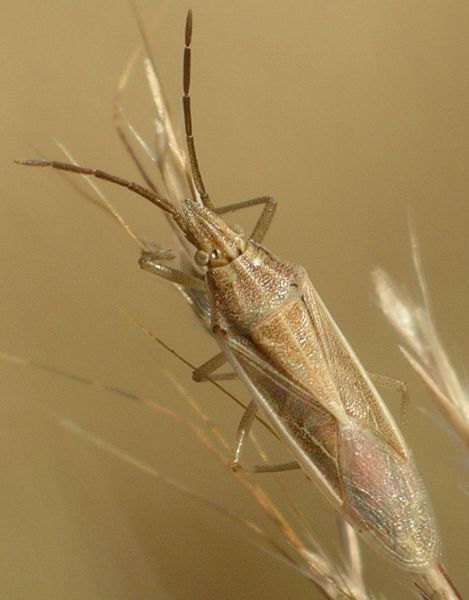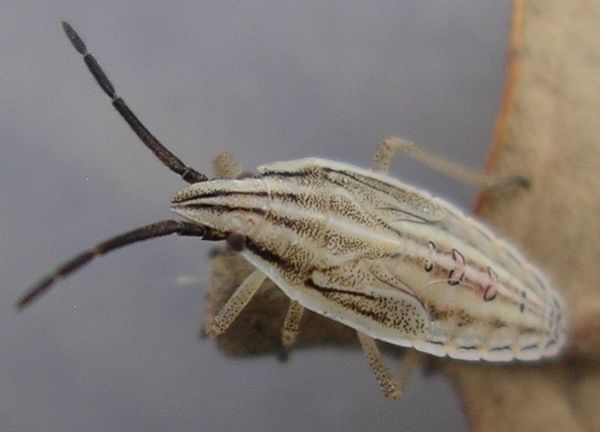 |
|
Mecidea Dallas, 1851
Mecidea Dallas, 1851: 131, 139.
Cerataulax Signoret, 1851: 335-336. (syn. by Dallas, 1852)
Type Species: Mecidea: Mecidea indica Dallas, 1851, by subsequent designation (Distant, 1902). Cerataulax: Cerataulax quadrivittatus Signoret, 1851, by monotypy.
Diagnosis:
Tribal Placement:
Included Species:
balachowskyii Villiers, 1954
indica Dallas, 1851
kristenseni Jensen-Haarup, 1922
lindbergi Wagner, 1954
var. virescens Wagner, 1954 [described as color
form]
linearis Dallas, 1851
longula Stål, 1854
lutzi Sailer, 1952
major Sailer, 1952
minor Ruckes, 1946
tasquillana Brailovsky, 1977 [junior synonym]
pallida Stål, 1854
var. virens Vidal, 1949 [junior synonym]
pallidissima Jensen-Haarup, 1922
ingramsi China, 1937 [junior synonym]
lepineyi Lindberg, 1938 [junior synonym]
straminea Vidal, 1949 [junior synonym]
lepineyi Vidal, 1949 [junior synonym]
sahariana Wagner, 1949 [junior synonym]
vidali Sailer, 1952 [unnecessary new name]
cadenati Villiers, 1956 [junior synonym]
pampeana Sailer, 1952
prolixa Stål, 1858
quadrivittata (Signoret, 1851)
rungsi Vidal, 1949
tellinii Schouteden, 1905
Key to Species Mediterranean Species
(modified from Derzhansky & Péricart, 2005)
|
1 Distance from apex of juga to an imaginary line passing through center of ocelli no more than 1.2 times the width of head through compound eyes |
2 |
|
- Distance from apex of juga to an imaginary line passing through center of ocelli 1.3 times the width of head through compound eyes (Morocco) |
rungsi Vidal |
|
2(1) Second antennal segment, in both sexes, distinctly expanded, thickened at base; in male specimens, second antennal segment very short, 0.4-0.7 times the length of third antennal segment; in female specimens, second antennal segment 1.33-2.0 times the length of third antennal segment; overall somewhat smaller and more slender; eyes relatively small; head from imaginary line drawn through ocelli to apex 1.15-1.35 times as long as width through eyes; length 7.0-10.7 mm. |
pallidissima Jensen-Haarup |
|
- Second antennal segment, in both sexes, at most only slightly expanded; overall longer and more stout; eyes relatively large |
3 |
|
3(2) Body remarkably stout, color always straw yellow; head shorter than wide; second antennal segment not or only very slightly widened at base; length 12.5-13.3 mm. |
pallida Stål |
|
- Body noticeably more elongate, punctures usually brown; head narrower, longer than wide; second antennal segment somewhat more distinctly widened at base; length 11.5-12 mm. |
lindbergi Wagner |
Key to Species New World Species
(modified from Sailer, 1952)
| 1 Abdomen with dark markings along midventral line | minor Ruckes |
| - Abdomen lacking dark markings along midventral line | 2 |
| 2(1) Males | 3 |
| - Females | 7 |
| 3(2) Pygophore with small tubercle near posteroventral margin | minor Ruckes |
| - Posteroventral surface of pygophore lacking small tubercle | 4 |
| 4(3) Third antennal segment shorter than second segment | major Sailer |
| - Third antennal segment equal to or longer than second segment | 5 |
|
5(4) Black spots just below trichobothria larger, each with greatest diameter equal to one-eighth the length of supporting segment |
major Sailer |
|
- Black spots just below trichobothria smaller, each with greatest diameter no more than one-twelth the length of supporting segment |
6 |
| 6(5) Pronotum strongly constricted just anterior to humeral angles | longula Stål |
|
- Pronotum with each anterolateral margin regularly and shallowly concave from humeral angle to anterior angle |
pampeana Sailer |
| 7(2) Third antennal segment cylindrical | longula Stål |
| - Third antennal segment flattened dorsally at least along basal third | 8 |
|
8(7) Black spots just below trichobothria larger, each with greatest diameter equal to one-eighth the length of supporting segment |
major Sailer |
|
- Black spots just below trichobothria smaller, each with greatest diameter no more than one-twelth the length of supporting segment |
9 |
|
9(8) Width of pronotum just behind cicatrices not exceeding length of second antennal segment |
minor Ruckes |
|
- Width of pronotum just behind cicatrices equal to length of second antennal segment plus at least one-half diameter of eye |
pampeana Sailer |
Comments:

Mecidea sp. (Texas) |
|

Mecidea sp. nymph (Texas) |
David A. Rider
Professor of Entomology
North Dakota State University
202 Hultz Hall
Fargo, ND 58105
E-Mail:
David.Rider@ndsu.edu
Published by the
Department of
Entomology
Prospective students may schedule a visit by calling 1-800-488-NDSU.